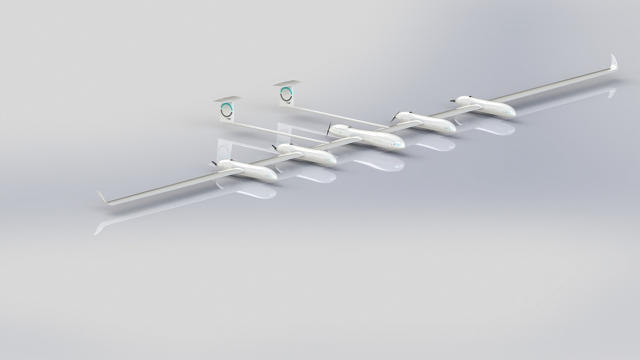(Source: fastcoexist.com)
 Over 4 billion people around the world still don’t have access to internet, and another 2.6 billion don’t even have a basic cell phone. Part of the challenge is the cost of buying a device when you make less than $2 a day, but it’s also expensive to build infrastructure in remote areas. Drones can help solve the latter issue: One new Wi-Fi connected drone is estimated to cost 100 times less than building traditional towers on the ground.
Over 4 billion people around the world still don’t have access to internet, and another 2.6 billion don’t even have a basic cell phone. Part of the challenge is the cost of buying a device when you make less than $2 a day, but it’s also expensive to build infrastructure in remote areas. Drones can help solve the latter issue: One new Wi-Fi connected drone is estimated to cost 100 times less than building traditional towers on the ground.
The new drone, from a Portuguese company called Quarkson, was designed to “make the Internet available to every person on Earth.” Both Facebook and Google are trying to do something similar–but, as of last month, Quarkson is now the first to actually have a prototype ready to test.
Quarkson’s SkyOrbiter LA25 can stay in the air long enough to make a communication infrastructure possible. “We extended the capabilities of the common drone,” explains Quarkson founder Miguel Angelo. “The common drone that runs on fossil fuels has an endurance of approximately 8-12 hours, never more than one day. With our technology, it’s possible to perform missions that take as long as two weeks.”
As the company builds out its fleet, it will also include a high-altitude drone that can fly continuously for as long as five years, using solar panels on the wings for power. The company hopes to replace satellites. “It is our objective to create a new type of aerial platform capable of acting as a pseudo-satellite at a fraction of the cost without the need to launch it into orbit,” says Angelo. The drones will also be easy to repair and upgrade, unlike satellites.
Angelo has been developing the aerial platform over the last decade, building on existing technology. “One major advantage is the reliability of our system,” he says. “It’s not an entirely new system, like Google and Facebook are building, that takes more time to mature. It’s a technology that’s based on conventional propulsion systems that we know work.”
The drones can also be used in disasters. “They can be used as an emergency telecommunications platform–a cell tower in the sky,” Angelo says. Unlike land-based systems, the drones could keep continuously working in a disaster. They can also be equipped with cameras and sensors to quickly monitor the ground and send information to emergency teams.
Sensors and cameras on the drones can also monitor the details of any large landscape–watching for wildfire risk or tracking fires, monitoring endangered species, or taking data from large farms to help farmers improve yield. In places where it’s difficult for humans to travel, like the North and South Pole, the drones could gather data about the changing climate. (Of course, they could also be used for more sinister purposes, like monitoring crowds or warfare).
The next step for the company will be getting permits to test their prototype, and building up partnerships around the world to try to bring it life. “If we want to help the world, we have to partner with other national and international partners, from governments to telecommunications companies,” Angelo says. “Alone we can’t make that change.”
Continue Reading at fastcoexist.com…
Alan is serial entrepreneur, active angel investor, and a drone enthusiast. He co-founded DRONELIFE.com to address the emerging commercial market for drones and drone technology. Prior to DRONELIFE.com, Alan co-founded Where.com, ThinkingScreen Media, and Nurse.com. Recently, Alan has co-founded Crowditz.com, a leader in Equity Crowdfunding Data, Analytics, and Insights. Alan can be reached at alan(at)dronelife.com







Leave a Reply